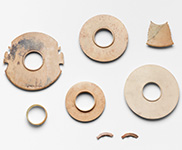Dr. Paul Singer
Individual
1904-1997
American
Relations
Agent: Frank Caro Chinese Art
Source: Edna H. Bahr, Dr. Fritz Bilfinger, C. T. Loo & Company, C. T. Loo Chinese Art, Alan Hartman, J. J. Lally & Co. Oriental Art, J. T. Tai & Co., John Sparks, Ltd., Oriental House LTD, Caroline L. Plumer, Laurence Sickman, Jun Tsei Tai
Place of birth: Presburg, Hungary
Place of activity: Vienna, Austria; Summit, New Jersey, United States;
Place of death: Summit, New Jersey, United States
Born in Presburg, Hungary, Paul Singer moved with his family to Vienna, Austria, in 1905. He purchased his first piece of Asian art in 1921 at age 17, when he began his studies at the Real Gymnasium in Vienna. From the onset of his collecting, Singer ignored the prevailing interest in enamel porcelain of the Qing dynasty (1644--1911), preferring Chinese archaeological artifacts instead. He collected throughout his life, becoming especially active after immigrating to this country in 1939. Beginning in the 1970s, Arthur M. Sackler began to support Singers collecting habit with an annual allowance. Singer bought from art dealers, auction houses, other collectors, and thrift stores chiefly in the New York metropolitan area. Upon Paul Singers death in 1997, the collectiontotaling some 5000 objectswas given to the Arthur M. Sackler Gallery. Singers purchase records are incomplete, but ongoing research is establishing the specific source of individual objects when possible.
Singer sometimes purchased objects that others thought were forgeries; some of them were authenticated through subsequent archaeological discoveries. At other times, Singer knowingly acquired copies and forgeries to highlight characteristics of authentic objects. A self-taught amateur collector, Singer's published opinions and observations amount to about twenty catalogues and position papers. Lacking the language skills to translate Chinese easily, Singer formed his judgments of ancient objects through highly disciplined direct study.
A trained psychiatrist, Singer shared an interest in ancient Chinese art with Dr. Arthur M. Sackler (1913--1987). They first met at a Sotheby's auction in 1957. Sackler underwrote a large portion of Singer's collecting activities. Singer, in turn, sometimes corrected attributions of individual pieces in Sackler's collection. At the time of his death in 1997, Singer had nearly five thousand ancient Chinese metal works, ceramics, and jade objects in his two-bedroom apartment in Summit, New Jersey. Singer bequeathed his holdings to the Smithsonian's Arthur M. Sackler Gallery. The bequest included the largest collection of ancient Chinese art--nearly three thousand objects--that the Smithsonian had received since the Sackler Gallery opened in 1987.
Literature
Writings by Singer:
Memoirs, first draft unpublished memoirs.
"Pre-Dynastic and Dynastic Shang Material," Oriental Art 6, no. 2 (Summer 1960), pp. 2--8.
"Pre-Dynastic and Dynastic Shang Material: A Postscript," Oriental Art 6, no. 3 (Autumn 1960).
"'Unique' Object in Chinese Art," Oriental Art 7, no. 1 (1961), pp. 2--4.
"Puzzling Object," Archives of Asian Art 41 (1988), pp. 91--92.
Max Loehr, Relics of Ancient China from the Collection of Dr. Paul Singer (New York, 1965).
Henry A. La Farge, "Archetypical China," Art News 63, no. 10 (February 1965), pp. 32--35.
Thomas Lawton, ed., New Perspectives on Chu Culture during the Eastern Zhou Period (Washington, DC, 1991).
Henry A. La Farge, "Paul Singer, A Sage Among Collectors," Orientations 31, no. 5 (May 2000), pp. 35--42.
One Man's Search for Ancient China: The Paul Singer Collection, exhibition at the Arthur M. Sackler Gallery, January 19--July 7, 2013.
Lee Rosenbaum, "The Crafty Collector," Wall Street Journal (March 5, 2013), pp. 1, 4.

